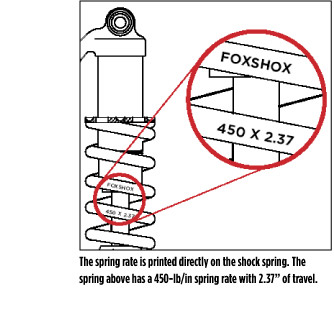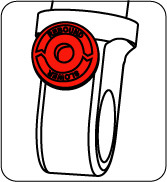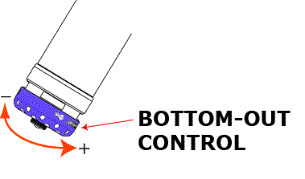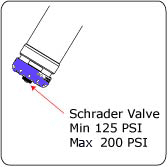|
|
Installing Your Shock | General Maintenance | Before You Ride | Setting Sag | Changing Springs | Measuring Sag | Adjusting Rebound | Dual Speed Compression (DSC) | Bottom-Out Control | Service Intervals | Important Safety Information
|
|
features/adjustments |
Dual speed high/low compression velocity sensitive damping (DSC), forged eyelets, increased shaft size, position-sensitive boost valve, increased oil flow for increased tuning range, adjustable bottom-out control, adjustable tuning range via Schrader valve, coil spring preload, rebound adjust |
|
spring |
coil |
|
|
intended use |
If you are installing your shock on a bike in which the shock is not original equipment:
Some things to consider:
Note: Do not use any solvents or de-greasers, as these products can damage the shock's exterior finish or its anodized parts.
Do not spray water directly on the seal/shock body junction. Do not use a high pressure washer on your shock.
To set sag on your DHX RC4:
If sag is lower than on the table, turn the preload ring counterclockwise. Always ensure that the spring is secure and does not freely move.
Note: After the preload ring engages the spring, turn the preload ring clockwise one turn. If the preload ring needs to be turned counterclockwise from this point to achieve proper sag, you will need to obtain a lower rate spring.
If sag is higher than on the table, turn the preload ring clockwise no more than two full turns after the preload ring engages the spring.
Note: If after the preload ring engages the spring and more than two full clockwise turns are needed to achieve proper sag, you will need to obtain a higher rate spring.
Shock Travel | Recommended Sag |
2.00/50.8 | 0.66/16.76 |
2.25/57.1 | 0.74/18.79 |
2.50/63.5 | 0.83/21.08 |
2.75/69.8 | 0.91/23.11 |
3.00/76.2 | 1.00/25.40 |
3.50/88.9 | 1.16/29.46 |
When placing the spring back on the shock body, it is important that the spring is correctly oriented. Essentially, the space in the spring retainer should rest on the flat part of the spring, and not on the segment of the spring where it starts to coil back under itself. Rotate the spring or spring retainer until the correct orientation is achieved.
An improperly oriented spring can fail prematurely, causing loss of control of the bicycle, which can result in serious or fatal injuries. The pictures below demonstrate correct and incorrect spring orientation. Correct spring orientation applies to all FOX Racing Shox rear shocks that utilize coil springs:


Rebound controls the rate at which your shock returns after it has been compressed. The proper rebound setting is a personal preference, and changes with rider weight, riding style and conditions. A rule of thumb is that rebound should be as fast as possible without kicking back and pushing the rider off the saddle.
The rebound knob has approximately 15 clicks of adjustment.
For slower rebound, turn the red adjuster knob clockwise.
For faster rebound, turn the red adjuster knob counterclockwise.


Turn the LSC adjuster clockwise by hand, to increase low-speed compression damping. The LSC adjuster primarily affects the compression damping during slow speed suspension movements, such as pedaling, g-outs or smooth jump landings. It also affects the wheel traction and harshness (or plushness) of your bicycle. The LSC adjuster has ~18 clicks of adjustment range.
With a 2.5 mm hex key, you can adjust the HSC adjuster by inserting the hex key into one of the angled holes. Turn the HSC adjuster clockwise to increase, or counterclockwise to decrease high-speed compression damping. The HSC adjuster mainly affects the compression damping during medium-to-fast suspension movements, such as steep jump faces, flat jump landings and square edge bumps. One of the best setups is to run with as little high-speed compression damping as possible, before (and without) bottoming. If you are bottoming out but like the way the shock is feeling, try increasing your bottom-out control before increasing your HSC. The HSC adjuster has ~12 clicks of adjustment range.


Bottom-out control affects the final part of the compression stroke. The knob is turned with a 3 mm hex key inserted into one of the holes around the perimeter. Do not use any other tool to turn the knob — use a 3 mm hex key only!
Turn the knob all the way clockwise for the most bottom-out control and counter-clockwise for the least. There are four (4) turns of adjustment.
Note: The factory pressure setting for bottom-out control is 160 PSI.
For more information about using the Fox HP hand pump to adjust the bottom-out control air pressure, see Changing the Bottom-Out Control Pressure.
The bottom-out control valve provides position-sensitive end stroke damping; this allows for a seamless transition from small bumps to big drop bottom-outs. The bottom-out valve is not adjusted directly. Instead, its behavior and performance characteristics are influenced by the air pressure setting in the reservoir, and by the adjustment of the reservoir bottom-out control knob. To change the range of bottom-out control damping characteristics of your DHX RC4 shock, attach a FOX High Pressure Pump to the air valve on the reservoir. For more bottom-out resistance, add 10-15 pounds of air pressure, to a maximum of 200 PSI. For less bottom-out resistance, decrease the shock’s air pressure by 10–15 pounds with the pump’s bleed valve, to a minimum of 125 PSI. Ride your bike and verify the settings before repeating the procedure.
CAUTION: Never ride your bike with less than 125 PSI, or more than 200 PSI in the reservoir air chamber. Doing this can cause damage to your shock, requiring repairs that are not covered under terms of the warranty.
![]()

Bushing Technology & Inspection | Seals & Foam Rings | Control Direction | Oil Volumes | Structural Inspection | Dropout Thickness Inspection | Torque Values | Unit Conversion | Suspension Tuning Tips | Using the Pump | Important Safety Information | Service Intervals | Contact FOX Service | Warranty Information | FOXHelp Service Web Site
Copyright © 2010
FOX Factory Inc.